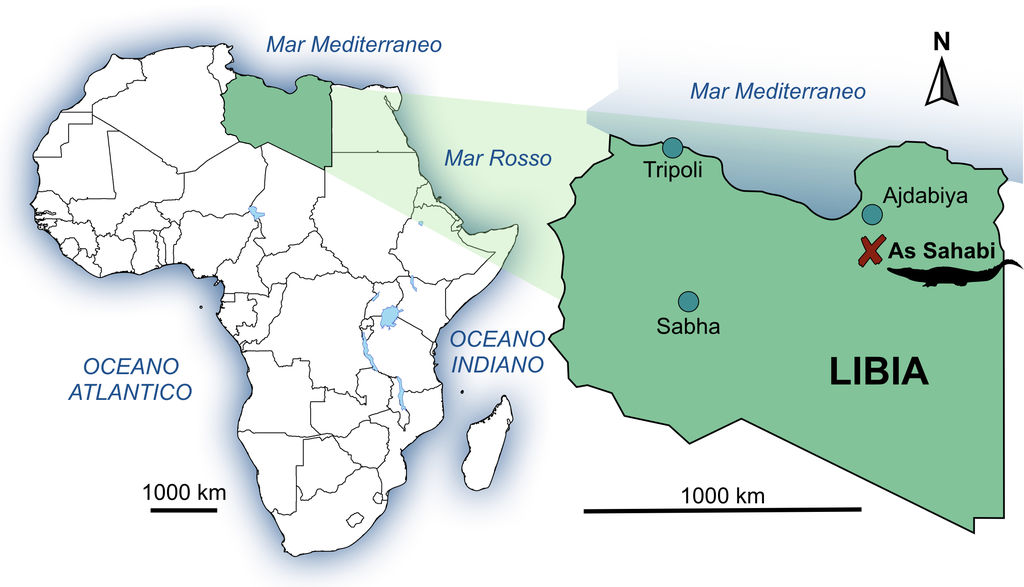
Seven million years ago the African crocodile crossed the Atlantic and colonised the New World
After a long crossing of the Atlantic Ocean, the explorer sees the mainland in the distance, a hitherto unknown continent, where a new history would soon be written.
It sounds like the chronicle of Christopher Columbus' landing in the New World about 500 years ago, but it is the result of a new study published on Scientific Reports journal which reconstructs a piece of the evolutionary history of crocodiles. Some specimens of crocodiles likely left North Africa about 7 million years ago and reached the coasts of Latin America, after probably crossing the Atlantic Ocean. They then adapted and diversified generating the species of Crocodylus, which still inhabits the American continent today.
The research places the Miocene African find, identified as Crocodylus checchiai, at the base of the evolutionary tree of the American crocodiles.
The study, developed by Massimo Delfino of the University of Turin and coordinated by Raffaele Sardella, Director of the University Museum of Earth Sciences (MUST) of Sapienza University of Rome, in collaboration with the University of Florence, reconstructed a 3D model of the only "survivor" out of five fossil skulls found in the early 1930s during a scientific expedition to As Sahabi (northern Sahara, Lybia). The fossil has been preserved in the museum in Rome for almost a century.
"The skull of the Crocodylus checchiai - explains Raffaele Sardella - is the best-preserved skull of this species. It lived in Africa during the Miocene, more than 7 million years ago, when the Sahara was a very different territory, populated by large mammals and rich in vegetation and waterways."
"We have seen that the crocodile of As Sahabi shares many anatomical features with the American species" - says Massimo Delfino of the Department of Earth Sciences of the University of Turin. "But not only that, we used specific software to compare the data obtained with the anatomical characteristics of other species, both existing and fossil. The aim was to carry out a phylogenetic analysis that clarified how this species represents a sort of link between African and American species."
"Ours is an extremely important result - says Lorenzo Rook of the University of Florence - which enhances the historical collections of a unique paleontological deposit for the understanding of the fauna of the Circum-Mediterranean area at the end of the Miocene."
By using tomographic scans, the researchers obtained 3D images of both the interior and exterior of the skull. Based on the size of the head, it could be established that the crocodile was of adult age and just over 3 metres long.
"These technologies - adds Dawid A. Iurino, researcher of the team that elaborated the CT scans carried out on the Libyan skull, now at the University of Perugia - opens great perspectives in the field of paleontological research and allows to analyse elements otherwise impossible to observe."
The outcomes of this study are also confirmed from a chronological point of view. In the New World, the oldest Crocodylus fossils date back to the beginning of the Pliocene (5 million years ago) and are much more recent than the species studied.
It is, therefore, possible that during the Miocene some specimens of C. checchiai crossed the Atlantic Ocean and landed on the coasts of Latin America.
Crossing such a wide stretch of sea, which in the Miocene was undoubtedly shorter than today, might seem surprising, but among today’s crocodiles, there are species able to tolerate the high level of salinity in seawater and to swim long distances in the open sea taking advantage of the surface currents.
Studies with satellite tracking conducted on some specimens of Australian sea crocodile (Crocodylus porosus) have revealed how, by using the currents to their advantage, these reptiles are capable of covering more than 500 km in the open sea, in a matter of days.
The results of this study represent a significant contribution to the reconstruction of the evolutionary history and paleobiogeography of crocodiles, i.e. the ways and times through which these reptiles have colonised different continents reaching their current geographical distribution.
References:
Old African fossils provide new evidence for the origin of the American crocodiles - Delfino, M., Iurino, D., Mercurio, B., Piras, P., Rook, L., and Sardella, R., 2020, Scientific Reports https://doi.org/10.1038/s41598-020-68482-5
Further Information
Raffaele Sardella
Department of Earth Sciences
Director of the University Museum of Earth Sciences (MUST)
raffaele.sardella@uniroma1.it





